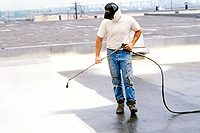
Photos courtesy of Engineering Diagnostics, Inc.
The owners of Barton Oaks Plaza Building II faced extensive flashing repairs as an alternative, which would have required complete removal and replacement of the building’s entire brick masonry exterior. By using the silicone coating to create a barrier system at the exterior wall, the building benefits from an immediate solution to the severe water infiltration problem without the need to remove the brick masonry veneer (BMV) or replace flashings, at about 1/5 the cost of re-cladding.
“Brick masonry veneer walls are not intended as barrier systems,” explained David Nicastro of Engineering Diagnostics, Inc. (EDI), the consulting engineering firm on the project. “Water can infiltrate the wall cavity from absorption or from cracks and voids in the masonry. Normally, a small amount of water runs down the back of the masonry to the flashings and out the weep holes.”
What EDI and contractor Taylor Waterproofing Plus, Inc. observed during a water infiltration study, however, was damaged flashings and failed sealant joints, which allowed wind-driven rain to penetrate every elevation on all floors except the first. The widespread leakage posed significant challenges to any remedial repair effort, and a full removal and replacement of the BMV was estimated at $1.25 million.
The only other option considered viable was to install an EIFS (Exterior Insulation and Finish System) barrier over the existing brick masonry and pre-cast concrete surfaces. While this alternative offered improved thermal performance, it would have significantly altered the aesthetics of the building, so it would no longer have matched the other four structures in the Barton Oaks complex. The estimated cost for this approach was $600,000.
Application
Instead, EDI called on past experience with BMV structures having similar problems, and recommended the silicone coating as a first option. “Obviously, stopping the water intrusion was our first priority,” Nicastro said. “But another benefit was the speed with which this option could be implemented. Using the AllGuard coating allowed Taylor Waterproofing to quickly address the existing leakage, with the least amount of tenant disruption among the options considered, and still obtain a reliable, long-term solution.”
Dow Corning AllGuard silicone elastomeric coating is a one-component, pigmented, waterborne silicone elastomer designed to waterproof above-grade exterior masonry substrates, such as concrete block, fluted block, brick, stucco, synthetic stucco, poured concrete, pre-cast concrete, EIFS and previously coated masonry substrates.
Because the building is currently occupied, Taylor Waterproofing personnel used brushes and rollers to apply the silicone coating, which was custom color-matched to replicate the brick exterior. Any damage to the cured material from abrasion or other sources can be easily repaired as the need arises.
“We’ve been using Dow Corning AllGuard coating since it was in its test phases more than 10 years ago,” commented Taylor’s Bill Herring. “We even participated in a marketing round table before the product was commercialized.”
“This project turned out particularly well, both from the standpoint of leak prevention and aesthetics,” added Taylor’s Austin branch manager Steve Schiber. “The color scheme matches the rest of the complex so closely that most observers wouldn’t even know it’s been coated.” Schiber estimated that his firm applied 760 gallons of the silicone elastomer in two coats, which covered nearly 38,000 square feet of exterior surface.

Sealing with Silicone
As part of the building’s remedial weatherproofing, Taylor crews also applied more than 22,000 linear feet of wet sealing on approximately 200 windows, as well as sealing all shelf angle joints, weep holes and mortar voids. All caulking was done with Dow Corning‚ 795 silicone building sealant, a high-performance material that is virtually unaffected by UV exposure, rain or extreme temperatures (-40 deg F/-40 deg C to 300deg F/149 deg C).In addition, the firm installed more than 180 linear feet of Dow Corning‚ 123 silicone seal, a pre-formed, ultra-low-modulus silicone extrusion that is bonded to substrates with silicone building sealant. The extruded seal is specifically designed for repairing construction joints and glazing details that have failed due to design error, field failure or when the lifespan of sealants and gaskets has expired.
For more information, contact Dow Corning Corp., P.O. Box 0994, Midland, MI 48686-0994; Phone 800/637.5377; Fax 989/496.8026; or visit www.dowcorning.com/construction.




